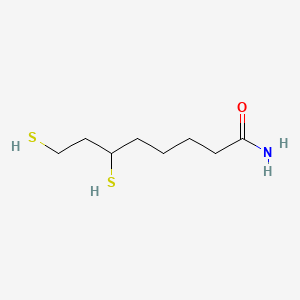| MeSH term | MeSH ID | Detail |
|---|---|---|
| Parkinsonian Disorders | D020734 | 20 associated lipids |
Dihydrolipoamide
Dihydrolipoamide is a lipid of Fatty Acyls (FA) class. Dihydrolipoamide is associated with abnormalities such as Wiskott-Aldrich Syndrome. The involved functions are known as Citric Acid Cycle, Electron Transport, NADH oxidation, Oxidation and Oxidants. Dihydrolipoamide often locates in Mitochondria, Mitochondrial matrix and Chloroplasts. The associated genes with Dihydrolipoamide are Mutant Proteins, Recombinant Proteins, mycothione reductase, Genes, Mitochondrial and alanylproline.
Cross Reference
Introduction
To understand associated biological information of Dihydrolipoamide, we collected biological information of abnormalities, associated pathways, cellular/molecular locations, biological functions, related genes/proteins, lipids and common seen animal/experimental models with organized paragraphs from literatures.
What diseases are associated with Dihydrolipoamide?
Dihydrolipoamide is suspected in and other diseases in descending order of the highest number of associated sentences.
Related references are mostly published in these journals:
| Disease | Cross reference | Weighted score | Related literature |
|---|
Possible diseases from mapped MeSH terms on references
We collected disease MeSH terms mapped to the references associated with Dihydrolipoamide
PubChem Associated disorders and diseases
What pathways are associated with Dihydrolipoamide
There are no associated biomedical information in the current reference collection.
PubChem Biomolecular Interactions and Pathways
Link to PubChem Biomolecular Interactions and PathwaysWhat cellular locations are associated with Dihydrolipoamide?
Visualization in cellular structure
Associated locations are in red color. Not associated locations are in black.
Related references are published most in these journals:
| Location | Cross reference | Weighted score | Related literatures |
|---|
What functions are associated with Dihydrolipoamide?
Related references are published most in these journals:
| Function | Cross reference | Weighted score | Related literatures |
|---|
What lipids are associated with Dihydrolipoamide?
There are no associated biomedical information in the current reference collection.
What genes are associated with Dihydrolipoamide?
Related references are published most in these journals:
| Gene | Cross reference | Weighted score | Related literatures |
|---|
What common seen animal models are associated with Dihydrolipoamide?
There are no associated biomedical information in the current reference collection.
NCBI Entrez Crosslinks
All references with Dihydrolipoamide
Download all related citations| Authors | Title | Published | Journal | PubMed Link |
|---|---|---|---|---|
| Hallström T et al. | Dihydrolipoamide dehydrogenase of Pseudomonas aeruginosa is a surface-exposed immune evasion protein that binds three members of the factor H family and plasminogen. | 2012 | J. Immunol. | pmid:23071278 |
| Phillips NJ et al. | Proteomic analysis of Neisseria gonorrhoeae biofilms shows shift to anaerobic respiration and changes in nutrient transport and outermembrane proteins. | 2012 | PLoS ONE | pmid:22701624 |
| Zuñiga J et al. | Cellular and humoral mechanisms involved in the control of tuberculosis. | 2012 | Clin. Dev. Immunol. | pmid:22666281 |
| van der Lelie D et al. | The metagenome of an anaerobic microbial community decomposing poplar wood chips. | 2012 | PLoS ONE | pmid:22629327 |
| Kareyeva AV et al. | Mitochondrial hydrogen peroxide production as determined by the pyridine nucleotide pool and its redox state. | 2012 | Biochim. Biophys. Acta | pmid:22503830 |
| Sasaki M and Nakanuma Y | Novel approach to bile duct damage in primary biliary cirrhosis: participation of cellular senescence and autophagy. | 2012 | Int J Hepatol | pmid:21994884 |
| Ten VS and Starkov A | Hypoxic-ischemic injury in the developing brain: the role of reactive oxygen species originating in mitochondria. | 2012 | Neurol Res Int | pmid:22548167 |
| Tam TK et al. | In situ regeneration of NADH via lipoamide dehydrogenase-catalyzed electron transfer reaction evidenced by spectroelectrochemistry. | 2012 | Bioelectrochemistry | pmid:22497727 |
| Finnegan PM and Chen W | Arsenic toxicity: the effects on plant metabolism. | 2012 | Front Physiol | pmid:22685440 |
| Jiang H et al. | Global analysis of gene expression profiles in developing physic nut (Jatropha curcas L.) seeds. | 2012 | PLoS ONE | pmid:22574177 |
